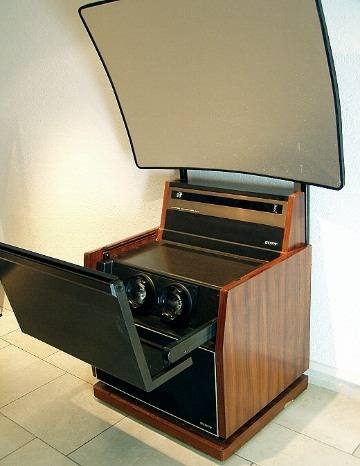|
|
 
|
|
Author
|
Topic: Dolby Cinema
|
Daniel Schulz
Master Film Handler

Posts: 387
From: Los Angeles, CA USA
Registered: Sep 2003
|
 posted 12-03-2014 12:49 PM
posted 12-03-2014 12:49 PM





Well this is certainly interesting:
http://www.hollywoodreporter.com/behind-screen/sensory-assault-dolby-takes-imax-753479?utm_source=Sailthru&utm_medium=email&utm_term=hollywoodreporter_breakingnews&utm_campaign=THR%20Breaking%20News_2014-12-03%2000%3A00%3A00_acouch
Dolby, the company whose name is synonymous with sound, is looking to make some noise in the world of images. The brand is set to launch Dolby Cinema, a premium, large-format theater experience that could challenge large-format leader Imax.
Dolby is the world's top brand in theater sound. Its new Atmos immersive sound, which was introduced in 2012, has been installed in roughly 700 theaters worldwide, and its fiscal 2014 revenue of $960.2 million is more than three times that of Imax. But Imax boasts more than 800 theaters worldwide, and Dolby sees an opportunity to move in on that turf.
Dolby Cinema will include special design elements — like signature entrances that can be programmed to reflect the movie that is playing — as well as giant screens and, of course, Atmos sound. But what's really piquing the interest of filmmakers is the system's ability to project "high dynamic range," a process in which whites appear whiter and blacks blacker. Gravity's Oscar-winning cinematographer Emmanuel Lubezki, for one, has said he's eager to make use of HDR. In fact, many insiders from Hollywood's technology community believe that consumers will see a noticeable difference with HDR, compared with the more widely touted "Ultra HD" 4K resolution and high frame rates.
Initially, Dolby's new projection system will use two Christie 6P 4K laser projectors for increased brightness (at press time Dolby expected to reach 31 FootLamberts for 2D and 14 FootLamberts for 3D) along with some proprietary Dolby technology, as well as the Dolby 3D system for stereo movies. Next spring, the system, co-developed with Christie, will introduce updated laser projectors and playback technology that will enable the system to project "Dolby Vision," the newest Dolby format, which combines HDR with some proprietary color secret sauce. (At this year's Consumer Electronics Show, Dolby also introduced Dolby Vision for TV.)
Earlier this year, Dolby quietly previewed its system at the Vine Theatre in Hollywood for leading directors, cinematographers and studio executives. More recently, it has staged demos at the Harmony Gold theater in Los Angeles. The first Dolby Cinema is now set to open in early December at the new JT Cinemas complex in Eindhoven, Netherlands. San Francisco-based Dolby is offering a profit-sharing deal to theater owners, who are expected to raise ticket prices. JT Cinemas' managing director Ron Sterk says that while the adult ticket price for his theater's standard auditoriums is about $12.50, the price for Dolby Cinema will be about $18.
JT plans to open additional Dolby Cinema auditoriums in the Netherlands, including a second in June and a third in late 2015, according to Sterk. The system's early adopters also include the UCI/Cinesa La Maquinista complex in Barcelona.
Dolby will supply theaters with the equipment, which is not inexpensive — the projectors alone run several hundred thousand dollars each — while the theater would cover the cost of the buildout. "It's not cheap, but we think the economics work," Dolby senior vp cinema Doug Darrow tells The Hollywood Reporter, noting "it has to have a meaningful screen count."
Meanwhile, Imax also is in the process of launching a laser-projection-based system for its auditoriums. And Technicolor has publicly said that it, too, is working on a way to deliver HDR to the cinema using developing laser-projection technology.
While Dolby lines up theaters in the U.S., it's busy closing studio partnerships to ensure movies will be created in Dolby Vision during postproduction. Film cameras and high-end digital cinema cameras, such as the Arri Alexa and Sony F65, can currently produce enough picture information to generate HDR images. Numerous postproduction-technology makers either support or have committed to support the Dolby Vision format.
"We are talking to all the studios. There's interest," says Darrow.
Disney is likely to be an early candidate, with J.J. Abrams' Star Wars: The Force Awakens (Dec. 18, 2015) waiting in the wings, as well as Brad Bird's Tomorrowland. And since Disney's 2012 Pixar hit Brave was the first film released with Dolby Atmos sound, it wouldn't be surprising if Pixar's next release, Inside Out, helps launch the Dolby Cinema brand with much fanfare when it opens in June.
| IP: Logged
|
|
|
|
Marcel Birgelen
Film God
Posts: 3357
From: Maastricht, Limburg, Netherlands
Registered: Feb 2012
|
 posted 12-03-2014 01:52 PM
posted 12-03-2014 01:52 PM




Yep, masking is sadly considered unnecessary gadgetry nowadays... You would expect Dolby to understand the importance, but I guess they're not making money on it so they don't care.
Also, this "HDR" concept will mess with the "visual DNA" of movies, maybe even more than HFR will ever do.
Once the JT cinema in Eindhoven opens, I will put some pictures up here and provide details regarding the real life implementation of this Dolby Premium Cinema Concept.
Still, when it comes to "immersive* cinema experiences", you should trust Dolby more than IMAX... Also, although they're bragging about it for years now, the first laser powered IMAX theater has yet to materialize...
* Yeah, that word again.
| IP: Logged
|
|
|
|
|
|
|
|
Bobby Henderson
"Ask me about Trajan."

Posts: 10973
From: Lawton, OK, USA
Registered: Apr 2001
|
 posted 12-04-2014 12:26 AM
posted 12-04-2014 12:26 AM




I can understand why Dolby is pursuing their Dolby Cinema concept from a marketing-sales perspective. And, judging from what I've read in the Hollywood Reporter article and seen in Dolby's 1 minute promotion video on Dolby Cinema the concept seems more driven by marketing rather than simply making the movie going experience as good as it can be.
The floating screen with no masking, halo lighted with LEDs or whatever, is a pretty big turn-off. It looks like a giant sized 1970's era projection screen TV. Bring back the masking. Better yet, bring back the layers of curtains too.
Dolby's cinema products, like Dolby Atmos, Dolby 3D and Dolby 7.1 have received next to nothing in terms of promotional support from both movie studios and exhibitors. The brands movie-goers see most often these days is IMAX and Real-D. That's about it. So it's obvious Dolby had to do something to make a high priced concept and make deals to give movie studios some of that tasty premium priced ticket money to get the Dolby brand front and center once again on movie posters and movie trailers.
It's still going to be a very hard sell to get movie theater operators on board with it.
The growth of "private label" premium big screen concepts (RPX, XD, Prime, etc.) movie chains have been developing in-house is clear evidence they're not all that keen having extra "partners." They don't like giving companies like IMAX or Dolby a huge cut of their box office take and kowtowing to various demands for everything from theater construction to bookings and marketing.
I also have to wonder how theater operators will feel toward Dolby and their cinema products. Dolby didn't wait much time at all to shift Dolby Atmos, a really high priced cinema product, into the consumer space. And now Dolby is literally going to be competing against at least some other theater operators with Dolby Cinema.
We also can't forget how the content from Hollywood has been performing lately. Some of the big theater chains aren't doing so hot. Maybe the public is starting to get tired of "Save The Cat" template-generated movies. The movies probably need to get a whole lot better and sell more tickets to get theaters on board with another high priced movie-going concept.
Is the general public even going to understand just what Dolby Cinema is and how it justifies a $6-$8 price premium? They sort of get the hype behind "IMAX," even if they're arguably being lied to in the process. Most people associate Dolby with surround sound and noise reduction. How much of the movie-going public is suffering from ticket price fatigue?
It's not going to be so easy to get movie productions to generate their content with Dolby Vision, Dolby Atmos and Dolby Cinema altogether in mind.
Right now not all that many movies are mixed in Dolby Atmos, and of the movies mixed in it not many really utilize the format very well. If you can't tell the difference between an Atmos mix and an "ordinary" 5.1 or 7.1 mix then what is the point?
Now we're going to expect movies to be shot somehow in Dolby Vision and/or "HDR?" I'm really kind of foggy on their idea of HDR. I really hope it's nothing like that garish, surreal crap I see in the still photography world. If movies start looking like that I'll just read more books!
Even if Dolby Vision just improves rendition of color, contrast and shadow/highlight detail, how is that going to fit into the "bit budget" of movie productions? We still see a lot of movies, regular 2D movies, being rendered in 2K. The 4K format, even in normal color bit depths, is considered a high priced format. What will productions have to do with cinematography, CGI, compositing, motion graphics, color grading and anything else to fit in with Dolby Vision? I can see a situation where a Dolby Cinema theater is playing a lot of standard color depth movies with only 5.1 sound. That's not going to be worth a high price premium.
I hope Dolby can do very well with Dolby Cinema, but I'm worried about its chances and also worried how it can impact sales of Dolby gear to movie theaters.
| IP: Logged
|
|
|
|
Marcel Birgelen
Film God
Posts: 3357
From: Maastricht, Limburg, Netherlands
Registered: Feb 2012
|
 posted 12-04-2014 04:03 AM
posted 12-04-2014 04:03 AM




Besides the lack of mandatory screen masking, the most depressing thing really is the name of the concept. "Dolby Cinema" is just another generic term, stacked onto the Dolby brand. This generic term "Cinema" will be the first to be dropped from people's minds.
While professionals and semi-pros will have no problem in discerning the "Dolby Cinema" theater concept from their range of professional cinema products and their implementation in home theater products, it doesn't really help for the normal consumer. Most people know Dolby from the occasional trailer in the theater and the stuff in their home theater. By using the same brands everywhere, the consumer is basically being told: The stuff you've got at home is as good as you get it in the cinema... Try to sell this to your exhibitors.
quote:
Now we're going to expect movies to be shot somehow in Dolby Vision and/or "HDR?" I'm really kind of foggy on their idea of HDR. I really hope it's nothing like that garish, surreal crap I see in the still photography world. If movies start looking like that I'll just read more books!
No, fortunately, it will not look like those under/over exposed composite stuff. This Dolby Vision is nothing more than a custom image format, to deliver a broader color gamut than currently possible within the DCI specs. The idea behind this is to be able to deliver the full potential of those laser projectors. Obviously, they need to work with studios to make this happen. This "secret color sauce" they're referring to, might be some "upconversion" process (DMR anyone?), to convert existing content to "Dolby Vision", but I'm not sure about this.
Still, this will eventually mess with how movies look like. There will be a lot of controversy around the merits of this. And eventually, there will be some changes to the DCI specs which will make a proprietary format pointless, but given the speed at which those things are being adopted, it might take a few years.
Dolby has been the king of vendor locked sound formats for decades, they lost their key to the throne room once DCI specs made Dolby Digital redundant. They’ve been breeding on proprietary formats for motion pictures ever since. First came Atmos, now Vision.
quote: Carsten Kurz
I never believed in this Dolby Vision crap. Looks like pure marketing gaga to me. And I haven't seen a single paper giving even the shortest line of real information on it. Dynamic contrast, local dimming, etc. has all been there for years.
It's obviously a lot of marketing b.s., but it's essentially about having a mandatory two projector setup for 3D instead of one using laser light sources and Dolby 3D, which will be brighter than anything out there yet and about having a wider color gamut. All neatly packed together in some marketable buzzword lingo...
| IP: Logged
|
|
Steve Guttag
We forgot the crackers Gromit!!!

Posts: 12814
From: Annapolis, MD
Registered: Dec 1999
|
 posted 12-04-2014 06:49 AM
posted 12-04-2014 06:49 AM




My guess is that they achieve the high contrast in a similar manner in which they did it for "Dolby Monitor"...since they are using laser projection, it is possible to modulate the light source. Also, by using lasers, you have the ability to have a more accurate color gamut (the more accurate your primaries are...and lasers are pretty monochromatic, the more accurate your color representations can be.
I agree though...if you are going to control the layout of the theatre...then by all means, IMPROVE THE LOOK of the theatre too. Demand things like curtains and masking!
What Dolby has on this high-contrast thing is something that other PLF (including IMAX) cannot duplicate using off-the-shelf equipment. Dolby gets a proprietary format in there.
I would presume, if the 6P laser system wasn't so expensive right now, they'd rather you just purchase the system and they wouldn't be a partner. However, to get the system launched, they are going to need to make it price attractive. Again, there isn't much loose money out there to spend on anything. People are already going for the comfy seats because there is a clear relationship to sales and the perception of a better experience with those.
| IP: Logged
|
|
|
|
Bobby Henderson
"Ask me about Trajan."

Posts: 10973
From: Lawton, OK, USA
Registered: Apr 2001
|
 posted 12-04-2014 09:55 AM
posted 12-04-2014 09:55 AM




I don't think the floating screen looks futuristic at all. It actually makes me think of really old big screen projection TV sets from the 1970's:

That's an image I grabbed from a Google Image search.
Has anyone else looked at the promotional video for Dolby Cinema? The decor in the theater looks very sterile and barren. I'd take a very opulent looking Warren Theaters "Grand Audiorium" scheme over that any day. It also looks like Dolby would be sinking a huge amount of money into the auditorium entrance. While it's nice to have an attractive entrance most of the money really needs to be spent where it counts: on the image and sound quality itself.
Regarding Dolby Vision and what it might change: movie-makers need to be on board with the idea up front. I think a lot of movie-makers would be pissed to see something they carefully adjusted in post production be changed by a proprietary digital projection front end. A lot of NLE, motion graphics and color grading software already allows one to do all sort of stuff to shadow and highlight areas, especially if they're working with raw, uncompressed camera hardware data. Honestly, what's going to stop others from just upping color bit depth and bypassing Dolby altogether?
quote: Carsten Kurz
How can Dolby increase the contrast of DLP DCI projectors if Barco, Christie, NEC, and TI can't do? Even their new laser projectors do not go beyond 1:3000 CR. Which is nice compared to the common 1:2000, but not as much as expected previouly.
This is very different on flat screens, which do not suffer from stray light and have very high contrast ratios for years.
And that raises the possibility of Dolby opening another Pandora's Box of sorts for theater operators.
Right now, razor-thin flat panel OLED TV displays are very expensive, high end items. But they're not going to be that way forever. The contrast ratios and deepness of black on those screens is utterly amazing. What's to stop Dolby from pushing Dolby Vision into the consumer space, particularly with OLED TV sets and doing so with "deep color" 4K content in home theater? Dolby is a publicly traded company now with a board more interested in growing profit margins than anything else. Preservation of the commercial movie-going experience might be a secondary priority to pushing consumer electronics sales.
| IP: Logged
|
|
|
|
|
|
|
|
|
|
All times are Central (GMT -6:00)
|
This topic comprises 11 pages: 1 2 3 4 ... 9 10 11
|
Powered by Infopop Corporation
UBB.classicTM
6.3.1.2
The Film-Tech Forums are designed for various members related to the cinema industry to express their opinions, viewpoints and testimonials on various products, services and events based upon speculation, personal knowledge and factual information through use, therefore all views represented here allow no liability upon the publishers of this web site and the owners of said views assume no liability for any ill will resulting from these postings. The posts made here are for educational as well as entertainment purposes and as such anyone viewing this portion of the website must accept these views as statements of the author of that opinion
and agrees to release the authors from any and all liability.
|

 Home
Home
 Products
Products
 Store
Store
 Forum
Forum
 Warehouse
Warehouse
 Contact Us
Contact Us




 Printer-friendly view of this topic
Printer-friendly view of this topic








![[thumbsdown]](graemlins/thumbsdown.gif)







